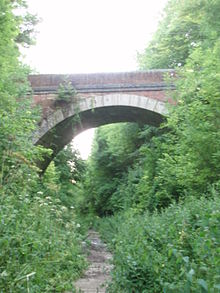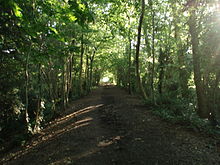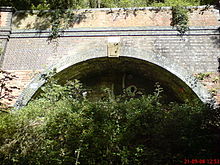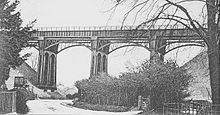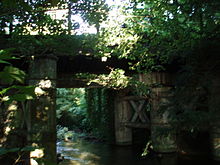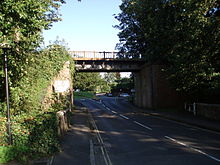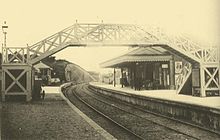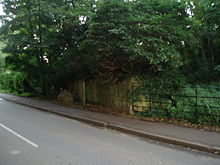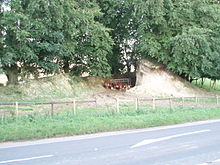- Meon Valley Railway
-
Meon Valley Railway Legend



Basingstoke and Alton Light Railway 



Alton 



Butts Junction/Alton Line 

Mid Hants Railway 






Farringdon Platform 



A32 



Tisted 



A32 (Hedge Corner) 



A32 



Privett 



Privett Tunnel 



A272 



West Meon Tunnel 







West Meon Viaduct 







West Meon 



Droxford 



Mislingford Goods Depot 



A32 



River Meon 



Wickham 



River Meon 



River Meon 



Eastleigh to Fareham Line 







Knowle Halt 



Former Loop Line 



West Coastway Line 



Fareham 



West Coastway Line 



former Gosport line The Meon Valley Railway (MVR) was a cross-country railway in Hampshire, England that ran for 22.5 miles (36.2 km) between Alton and Fareham, closely following the course of the River Meon. At its northern (Alton) end, it joined with the Mid-Hants Railway to Winchester, the Alton Line to Brookwood and the Basingstoke and Alton Light Railway. At Fareham it linked with the Eastleigh to Fareham Line, the West Coastway Line and the line to Gosport. The railway was authorised in 1896 and opened in 1903, making it one of the last railways of any size to be built to main-line standards in the United Kingdom.
Background
The MVR was built by the London and South Western Railway (LSWR), which had a virtual monopoly on railway services in southern Hampshire. It already operated services between London (from its Waterloo terminus) and Southampton and Portsmouth. The former destination was served by the South Western Main Line and the latter by the Portsmouth Direct Line, as well as the line from Eastleigh via Fareham.
Despite this, the LSWR felt that it would be advantageous to build a more direct line between London and the Portsmouth area (especially Gosport). Alton was becoming an important railway junction and a thriving market town, as was Fareham. A line between the two that ultimately connected London and Portsmouth was an attractive proposition. Like many, the LSWR anticipated a growth in tourist and holiday traffic to the Isle of Wight, which had become a popular destination in the late 19th century. Steamer services to the Island departed from Stokes Bay, and the LSWR already had a small station there, connected to Gosport railway station by a short spur line. Since the 1880s Lee-on-the-Solent had developed as a small but promising resort, and the LSWR had constructed a branch line to the town from Gosport in the 1890s. A railway down the Meon Valley would allow a much shorter run to the Gosport peninsula – as things stood, services had to take either the South Western Main Line, which ran out to the west, or come from the east via the busy junction at Havant. There was also support from the military for another main-line from London to Portsmouth. During the late 19th century there was considerable unease between Britain and France, with some in the British government fearing a large naval attack on Portsmouth or even an invasion. This led to the construction of numerous forts and barracks in the area around Portsmouth, and the Admiralty openly supported any increase in railway capacity to ease the movement of troops and equipment to the South Coast if needed.
There was also an element of railway politics in the decision to build the railway. Throughout the mid- and late- 19th century the LSWR's strongest rival was the Great Western Railway. The LSWR had extended its lines as far as Padstow in Cornwall, which was deep in GWR territory. The GWR had long sought to have its own line from the West Country to the booming ports of Southampton and Portsmouth. To this end, it had acquired running rights over the Didcot, Newbury and Southampton Railway in the 1880s. However, this did not provide a fully independent route. In 1895 the GWR had made a basic proposal for the Portsmouth, Basingstoke and Godalming Railway, a line to the south coast from Reading, then south to Basingstoke, down the Meon Valley and then passing through Southwick and Bedhampton, where it would join the line into Portsmouth. Nothing came of this proposal, but the LSWR clearly believed that it should deny one of the last routes to the coast to its rivals. In 1896 the LSWR drew up plans for two railways- the Basingstoke and Alton Light Railway and the Meon Valley Railway, thus effectively blocking the entire length of the GWR's proposed route.
Compared to many cross-country lines, the Meon Valley Railway project had an easy birth. The necessary Act of Parliament was quickly obtained, with the South Western (Meon Valley) Act receiving Royal Assent on the 3rd June 1897. A contractor was hired to carry out the work: Relf & Son of Plymouth. The LSWR's chief engineer of the works was W.R. Galbraith. T. P. Figgis was the line's architect for stations and other non- permanent way structures.
Design
The decision had been taken to build the line to main-line standards, with a ruling gradient of 1-in-100 (1%) and only gentle curves. Stations would be constructed with 600-foot (183 m) long platforms capable of taking 11-coach express trains. The earthworks were to be built to take a single track, but all bridges and tunnels were to be built to dual-track standards. If the line proved successful, it would be upgraded to full-length dual track. As constructed, only the stations had dual tracks, so they were the only places trains could pass each other on the line. The design of the MVR also made much use of grade separation to minimise the use of level crossings, which were coming to be seen as both dangerous and undesirable, especially on lines intended for faster services. Instead all public roads that crossed the route of the line were accommodated by bridges over the line or under the railway, even where this required extensive earthworks and realignment of roads (such as at Hedge Corner near Privett and the site of Droxford station). Whilst there were still 19 level crossings on the line, the majority were in fact crossing points for footpaths, the remainder being for lightly used farm tracks, connecting land that had been cut in two by the construction of the railway. The LSWR's promotional material for the line showed the line as a direct London-Gosport route for express services.
Due to both the requirements for gentle gradients and the hilly terrain of the Meon Valley the line required some impressive engineering works, including two tunnels and a 62-foot (19 m) high viaduct at West Meon. The summit of the line was at Privett, some 519 feet (158 m) above sea level. As was not unusual with railway construction, due to the constraints of the landscape, a few of the stations were some distance from the settlements they claimed to serve (especially Privett and East Tisted). At the time, several commentators pointed out that these stations were in fact much better placed to serve the large country houses in the area (Basing Park and Rotherfield Park respectively). This point was further emphasised by the naming of the stations. Stations were usually named after the parish they were built in, but the owner of Basing Park insisted the LSWR name the station Privett (instead of the intended name of 'West Tisted') after the much smaller village in the area, next to which his estate was sited.
As befitting a railway built to full standards, the stations were impressive. With leanings towards the Arts and Crafts movement, the stations were built out of brick in a mock-Tudor style, with Portland Stone mullions and gables. The architecture included stained-glass door windows and tiled interiors. The lavatories were in outbuildings styled like Chinese pagodas. Goods yards were planned for Mislingford (mainly to serve a local pumping station) and Farringdon, and all the stations had goods sidings, an ornate corrugated iron goods shed and hand-operated cranes to allow parcels and goods to be picked up and dropped off as needed.
Construction
Construction began in 1898, with the first soil being cut just south-east of Farringdon. An excellent review of the "New" railway is available in The Railway Magazine Vol 12 p499 [1]. The photograph from this article - approximately a century ago - of Privett station, as its building was nearing completion, is almost identical to the modern photograph to the right of this paragraph. The first task was the laying out and excavating the cuttings to provide material for building up the embankments. The embankments, tunnels, rails, stations, bridges and other structures were then built, with the construction teams starting at the Alton end of the line and moving south. Initially the terrain was easy, with only minimal earth-moving required (considering that the majority of work was done by manual labour). The main problem was obtaining a water supply for both the men and the small steam locomotives used for hauling supplies, since the railway was passing along chalk soil. The further south the railway came, the more undulating the terrain became and greater works of civil engineering were required to maintain the strict gradient requirements of the railway.
After the construction of Privett station, the contractors came to their biggest engineering work – the Privett Tunnel. At just over 1,000 yards (914 m) in length, the tunnel also followed a vague 'S'-shape, so the centre of the tunnel was in total darkness. Steam shovels and horses were used to remove the spoil (the latter were lowered into the works down shafts). The ground the tunnel was being driven through was found to be solid enough that the tunnel did not have to be lined with brick- the inner walls of the tunnel are plain, unworked chalk rock. A collapse in the tunnel trapped two navvies – one of whom died of suffocation. The other managed to dig himself free with his pocket knife and was rescued after being trapped for over 24 hours. A second man was killed after being hit by a locomotive. These deaths caused some men to leave the works- enough to make the contractors bring in two steam shovels and a traction engine to speed up progress. The tunnel was built by two teams working from opposite ends, and when the two met they were less than an inch from their planned course.
Between Privett and West Meon the railway had to be built on an embankment some 64 feet (20 m) high. This earthwork crossed the A272 road to Petersfield, which was accommodated by a short brick-lined tunnel through the embankment some 167 feet (51 m) long.
A second 600-yard (549 m) tunnel was built on the approach to West Meon, but before the railway could reach the site of West Meon Station, it had to cross the River Meon itself, which at this point ran through a narrow but deep valley. An 8-arch concrete viaduct was planned, but the ground was not as strong as initial tests showed, and very soon after construction the foundations of the viaduct began to subside. A 4-arch iron design was used instead, with large chalk embankments on the approaches over the unstable ground. The viaduct dwarfed the surrounding village, standing over 62 feet (19 m) high. Despite being much lighter than the concrete design, the whole structure weighed over 700 long tons (711 t; 784 ST) and cost £10,000 to build (£692,000 today). It is rumoured that 2 partially complete arches of the original viaduct are buried within the northern embankment.
West Meon station was the only point on the line where trains could take on water. A deep artesian well was sunk into the hills east of the station and piped to a tank in the station's goods yard to supply a water column on each platform. West Meon was also chosen as the site of the temporary 'village' of wooden huts to provide accommodation for the navvies and their families. A smaller collection of huts had been built at Privett.
Having crossed the Meon Valley, the railway then passed through easier country, gradually descending through means of a series of embankments and cuttings. The chalk soil supported many streams and rivulets, so at several key points the builders provided culverts or narrow bridges to provide drainage.
South of Droxford, the workers encountered the Reading Beds – an area of clay and gravel that, as part of the larger Fareham Clay Beds, made the area a centre for brickmaking. However, the soil was highly unstable – when wet it was almost liquid, whilst in the summer it was as difficult to work as concrete. Huge amounts of chalk soil excavated from the two tunnels were brought in to stabilise the trackbed and to build embankments, but throughout the life of the railway subsidence was a problem along this stretch. The clay soil also led to standing water and flooding during heavy rain, and a number large grilled drains were provided along the line between Mislingford and Knowle. The problem was so severe in a cutting just north of Wickham that a concrete retaining wall was needed to support the side of the cutting and to prevent flooding the cutting was deepened to allow the construction of foundations of large concrete blocks for trackbed, on top of which were piled bricks to allow drainage before the topsoil and ballast could be laid. To improve the stability of the track itself the section between Wickham and Droxford used concrete sleepers- an early adoption of these on a British railway.
The line then passed through the Forest of Bere before heading across the water-meadows at Wickham on an embankment. The embankment crossed the River Meon itself, requiring the river to be taken through a long brick skew tunnel. The embankment also effectively divided the village of Wickham in two, with two new bridges providing the only means of crossing under the railway. This remains the case today. Just south of Wickham, the Meon was crossed again on a steel bridge supported on 6 tubular steel pillars – this was the second biggest bridge on the line after the West Meon Viaduct. The meandering course of the Meon, the constraints of the landscape and the railway's ruling gradient meant that the railway required 5 under-bridges within half a mile (1 kilometre)- 3 to cross the Meon (including the steel bridge near Wickham station) and the 2 to cross roads in Wickham.
Finally, the railway gradually dropped to the natural ground level to the south of Wickham, joining the Eastleigh to Fareham Line just north of the Knowle Hatches Viaduct. Trains from the Meon Valley then passed down this line and into a newly built platform at Fareham station.
The construction of the MVR also included the building of a 2-mile (3.2 km)stretch of line between Fareham and Knowle Junction to bypass the Fareham Tunnel, which had suffered serious subsidence problems due to being built through the local clay beds. The tunnel frequently had to be closed for maintenance and shoring-up, so a bypass line was urgently required, especially given the anticipated increase in traffic caused by the new line. The double-track line ran through the north of Fareham and the village of Funtley, re-joining the main line just south of Knowle Hospital. Construction of this line took place once the Meon Valley Railway was completed, starting in October 1904 and being completed in 1906.
The total cost of the Meon Valley Railway, including the Fareham tunnel by-pass, was £399,500, 2 shillings and 3 pence. This equates to about £27.7 million at today's prices. In all, the navvies (only minimally assisted by mechanical equipment) moved 340,700 cu yd (260,484 m3) of earth in the course of the works.
Early history
The various delays during construction (such as the need to re-design the West Meon Viaduct and the ongoing problems with stabilising the track through the clay beds) caused the LSWR to delay opening of the MVR by a year. There were further delays in installing the signalling equipment. The line finally opened on 1 June 1903. There were between 8 and 11 services a day, running 4- and 6-coach trains. London-Gosport services were hauled by Adams 'Jubilee' engines. The lighter Alton-Fareham trains were worked by Adams 'Radial' and Adams O2 Class tank engines (a 'Radial' hauled the first public train on the line). Twice a day the line was used by a London-Gosport fast express service, usually hauled by a Drummond T9 'Greyhound'.
As was expected in such an agricultural region, the bulk of traffic came from shipping agricultural produce. On the MVR this included watercress, wheat, fruit (especially strawberries and apples), milk and cattle. The LSWR put on special market-day trains, with both passenger carriages and livestock cars, allowing farmers to accompany their livestock. There were local 'pick-up/set-down' goods services along the line, which called at every station to deliver and pick up any waiting goods. No shunting engines were stationed on the MVR, so the locomotive working the train had to uncouple at each station and marshal wagons into and out of the train as required- standard practice for a rural line. Heavier freight services were often powered by locomotives such as the Drummond 700 Class.
Local residents and businesses had high hopes for the railway. The 'Railway Inn' was built next to Droxford railway station in the hope of accommodating tourists and travellers. A public house was built next to Privett railway station named 'The Privett Bush'. Coal merchants did good business – West Meon station employed no fewer than three different merchants, and one business supplied coal to 2 of the stations.
Many local newspapers were impressed by the line's speed, the scale of its engineering works, the high standards of the stations and other structures and the beauty of the scenery it passed through. Then, as now, the link between the Meon Valley and the famous figures of Gilbert White and Jane Austen was made several times. Some papers wrote articles describing the route and its scenery in great detail, pointing out places of interest along the line, such as the hill fort at Old Winchester Hill.
Following the opening of the Fareham Tunnel deviation line in 1906 (see above) the original route through the tunnels was closed to allow major repairs that ultimately led to the existing tunnels being stripped out and new linings being built. During this period all traffic north of Fareham used the new double-track bypass route. With the tunnels completed the track was relaid with a new layout. Knowle Junction ceased to be a true junction as the connection between the MVR and the Eastleigh to Fareham Line was removed, although the signal box was still used to hand over and collect the Tokens to MVR trains. The MVR now had a totally separate but parallel single-track line across the Knowle Hatches Viaduct (which was widened to triple-track width) and through the tunnels. In true MVR style this route was laid out to allow conversion to double track in the future. The route from Eastleigh continued down the deviation line, joining the original track just north of Fareham Station. This layout was intended to allow fast services from the MVR unrestricted access to Fareham and Gosport without the possibility of being held up at Knowle.
As part of these works in 1907 a halt was built at Knowle Hospital to serve both it and the village of Funtley[2]. This small station - little more than a platform and a shelter, became one of the first rural stations in Hampshire to be lit by electricity, since it took its power from the hospital's generators. Given the original track layout it was served only by local trains on the Meon Valley Railway, but following the reinstatement of Knowle Junction in 1921 (see below) certain trains on both routes used the stop.
Unfortunately, the expected London through-traffic never materialised, and after only a few years the London to Gosport services were cut back. Similarly, the tourist traffic to Stokes Bay also failed to grow, with steamers preferring the more established ports at Portsmouth and Southampton. Even during the First World War, traffic was light compared to other lines, despite the line partly being built for military traffic. In fact, in 1915 the regular London traffic was suspended totally, and the services were never reinstated. From then on the MVR only handled regular traffic between Fareham and Alton. The only major troop movements were from local regiments. Droxford station had a brief moment in the public eye when Admiral Doveton Sturdee arrived at the station on his way to his nearby home after his victory in the Battle of the Falkland Islands in 1914).
Occasionally special trains from other parts of the network used the line, and the MVR did see infrequent use as a 'spare' mainline during periods of high traffic such as the summer holiday season or Christmas.
The most obvious signs of the railway not developing as expected were the series of changes made to the signalling arrangements in 1921. Privett signal box was effectively closed and the line was changed from being worked as a single-track main line to operating as a single-track branch line, with longer signal blocks and fewer passing loops (the 'down' platform at Privett was closed, the second line through the station now being only used for shunting). At the southern end the rail connections at Knowle Junction were relaid. This allowed trains from Fareham heading to Eastleigh to use both the original and the deviation lines but the layout of the junctions meant that MVR trains could still only use the original single-track route. The LSWR's concerns about holding up express traffic no longer applied as such trains were not regular users of the MVR anymore.
Southern Railway
The LSWR was merged into the Southern Railway in 1923. By then services had been reduced even further. There were now 6 or 8 services a day, mainly formed of 2- or 3-coach trains hauled by Drummond M7 tank engines, with T9s remaining for faster services. Goods services remained vital to the line, with a twice-daily service — one trip south-bound and one north-bound. Wagons and trucks would be shunted into the train at the three goods yards by the locomotive.
Winter of 1927 brought storms and heavy snowfall to the Meon Valley region. A special Waterloo-Gosport train running down the line at 5:40am on the 27th December became stuck in a huge snowdrift near Tisted. Workmen took nearly a day to free the train and clear the line.
Since the railway opened, there had been calls for a station at Farringdon, just south of Alton. A goods yard for loading agricultural produce was already sited there, and in 1930 a short wooden platform of one coach-length was built to serve the village. Requests for a similar platform and yard at Meonstoke were not acted on, although the planners of the line had allowed for the future construction of a yard at that location. A single section of rail, dug vertically into the ground, marked the possible site for such a yard until after the railway closed- it was finally removed in the 1960s.
In 1931 a further down-grading of the MVR took place when the track at Butts Junction (the approach to Alton station) was re-laid. The signal box was removed and the MVR's direct connection with the Alton Line to London was removed, meaning that MVR trains now ran direct to a bay platform at Alton station. It also meant that trains could not run direct from the Alton Line to the Meon Valley as they had been able to- if this was required trains had to shunt from one line to the other. This change spelt the end of the MVR as an integrated part of the railway network- it was now simply handling stopping local traffic with none of the fast inter-city express traffic that the line was built to handle and that used the line in its early days.
The Alton Line was converted to electric operation in 1937. It was decided that it was not viable to electrify the MVR, and with that decision went any realistic hope of the line being upgraded to the dual-track standards to which it was built (indeed, the railway would remain single-line for its whole existence).
This period saw changes to the stock used on the MVR. The M7 tank engines remained the main type used, but goods services on the line was now being worked by types deemed redundant for main-line passenger working, such as a small number of Drummond L12s, which had been the LSWR's cutting-edge express locomotives when the line was built. T9s also began to be used for freight services and shunting. Some newly built types were used during the summer for heavy agricultural trains or tourist services to the coast, such as the Maunsell U-Class.
By the outbreak of the Second World War in 1939, rural lines such as the MVR were all coming under threat from rural bus services, and even goods services were being threatened by local lorry services. The bulk of passenger services were now being run by M7 tank engines with a 2-car 'push-pull' train (carriage sets where the locomotive can be controlled from the rearmost carriage, negating the need to turn the train). These trains looked decidedly lost against the long platforms designed to take up to 11-car expresses. The huge platforms were, in fact, deemed so unnecessary that at West Meon new access slopes were cut halfway along and a walkway constructed across the tracks- the remaining half of each platform was effectively abandoned and allowed to grass over.
Wartime
During the Second World War the line was yet again used lightly compared to other railways in the region (such as the Didcot, Newbury and Southampton Railway). The only real change was an increase in goods traffic supplying the naval dockyard at Portsmouth. This saw new locomotive types running over the line, such as Drummond 700s and the distinctive Bulleid Q1s. Standard passenger services had a box van added to cope with the near-constant stream of parcels and luggage to and from Portsmouth. A few troop trains used the line late at night. In 1941 a special military freight train, hauled by a Drummond 700, was stabled for the night at Tisted, with the crew receiving instructions to stay with the engine and be ready to depart instantly in an emergency. Although unknown to both the locomotive crew and station staff, the train was carrying 48 mines.
Despite this relatively light military traffic, the Meon Valley Railway did come under attack during the war. A Junkers Ju 88 dropped bombs at Droxford station during 1940. These missed the station building and tracks but destroyed two railway worker's cottages. The aircraft then dropped further bombs at Soberton, but these also missed the railway. The bomber then turned around and headed up the line to the West Meon Tunnel, and a single bomb was dropped at the northern portal. A direct hit was not achieved, but a short section of line, including several sleepers, was destroyed and a crater was left in the ballast. All trains were quickly halted and the line was repaired in a few days.
Despite what was, on the whole, a fairly quiet wartime career the MVR had a brief spell of intensive use during the build-up to D-Day when huge amounts of men and equipment had to be moved to the south of England, kept in readiness and finally transported to ports. Large numbers of Tanks were moved by rail to Mislingford goods yard where they were dispersed to numerous concrete hard-standings built in local lanes and fields for temporary storage. Mislingford was also the site of a temporary wooden platform to serve the large number of Canadian troops who were encamped in the Forest of Bere.
The MVR had one crucial role to play in the D-Day operations. On Thursday, June 2, 1944, Winston Churchill, U.S. General Dwight D. Eisenhower, the Prime Ministers of Canada and South Africa, William Lyon Mackenzie King and Jan Smuts, and other Allied leaders met in a special train at Droxford Station (the train was actually the Royal Train from the London, Midland & Scottish Railway). The station possessed the longest siding in southern England (outside the railway works at Eastleigh) and was close to a deep cutting. If threatened by an air raid, the train could be pushed into the relative safety of the cutting. During this meeting, final decisions regarding the planning of Operation Overlord were made.
Post-War and British Railways
The Southern Railway was nationalised into British Railways in 1948. No immediate changes were made, with the standard 2-car 'push-pull' sets running around five services a day. However, the rise of private car ownership and a major shift of local goods traffic from rail to road saw the MVR become increasingly uneconomical to operate. Services were gradually run down. This led to even lower passenger numbers as the service became less and less frequent, and more people switched to using cars or buses.
During the early 1950s, British Railways drew up its 'Modernisation Plan'. This mainly concerned itself with the planned withdrawal of steam locomotives and the electrification of its main trunk routes. However, the plan also listed several lines that could be closed either because they were redundant in a nationalised, competition-free network or because they were unsustainable to operate. The Meon Valley Railway fell into both these categories.
Gradual closure
On 5 February 1955 the Meon Valley Railway closed to passenger traffic, although the goods services were retained. As is often the case, passenger numbers rocketed in the final weeks of operation, as people took a final ride on the railway. It should be noted that the closure was long before the 'Beeching Axe' of the 1960s, where many well-used but uneconomic railways were closed. There is little doubt that in 1955 the Meon Valley was unsustainable as a passenger railway.
The day after 'official' closure to passengers, a special train called 'The Hampshireman', organised by a rail enthusiasts' group, ran along the full length of the line - the last train to do so. It was hauled by two T9s 'double-heading'.
Goods services were to continue with a once-a-day service from Fareham to Droxford, and a similar service from the northern end only from Alton to Farringdon. The section of line in between (including West Meon, Privett and East Tisted stations) was lifted. This included the demolition of the West Meon Viaduct. The huge iron bridge had a high value in scrap, and thus was one of the first structures to be demolished (had it been built from concrete as originally planned it would probably still be standing). During the viaduct's demolition, it was found to be suffering from corrosion in several places which would have needed extensive and costly repairs in the near future if the railway were to remain open. This was seen as a further justification of the closure by some at BR.
Staff numbers at stations had been hugely cut, and even though the line was officially 'open', the station platforms were overgrown and much of the infrastructure neglected.
As British Railways was urged to cut costs throughout the 1960s, the southern goods service to Droxford was withdrawn in 1962. The last BR-scheduled passenger service on any part of the MVR had been the 'Solent Limited' railtour on the 30th April 1961 (a year to the day before the section was closed). A goods service to Farringdon was maintained until 1968, when the final part of Meon Valley Railway was closed to all traffic.
Post-closure
After the 1962 closure of the southern portion of the line, a Mr. Charles Ashby purchased Droxford station and the right to run trains over the railway. He used it for testing a design of railbus that he had developed called the Sadler Rail Coach or 'Pacerailer'. Like the similarly named British Rail 'Pacer' of later years, this was essentially a bus-style vehicle. Unlike the later BR types, the Sadler Rail Coach used road-vehicle style pneumatic tyres on its drive wheels and flanged steel wheels at each end to guide it along the track. As well as the MVR itself, a special steep-gradient section of track was built for testing at Droxford. A company called Sadler Vectrail Ltd was established in 1966 to re-open the Ryde to Cowes railway on the Isle of Wight using Sadler Rail Coaches and the prototype vehicle appeared briefly at an Island Industries Fair but the scheme was unsuccessful.
Mr Ashby also purchased an LBSCR 'Terrier' tank engine no. 32646, which he brought to Droxford but in May 1966 this was sold to Brickwoods, the Portsmouth-based brewer, for display outside a public house on Hayling Island.
The northern section of line to Farringdon was lifted almost immediately after closure. The two tunnels at West Meon and Privett were sold to private users. West Meon Tunnel was used by a scrapdealer for breaking up ex-military vehicles and aircraft until the 1980s, whilst Privett Tunnel was used for growing mushrooms.
The southern portion of the line also became home to a steam locomotive preservation society, which planned to operate the section as a preserved railway. To this end, they moved several locomotives (including a 'USA' tank engine) as well as rolling stock, to Droxford. However, a fire at the site, and the fact that BR planned to sever the connection with the Eastleigh to Fareham line, thus cutting off any preserved railway, meant that plans came to nothing.
Once the mainline connection was gone, Ashby used two small Ruston-Hornsby diesel shunters and two ex-BR carriages to operate private-charter trains for a short time. The line south of Wickham was lifted in 1974, and the last remaining section between Wickham and Droxford in 1975. The last vehicle to run on the MVR was an Austin Mini-based railcar owned by Charles Ashby.
Today
Despite the lifting of the entire track, the MVR has physically survived well. The section between Knowle Junction and the West Meon Viaduct is now an 11-mile (17.7 km) bridleway (rail trail), the Meon Valley Trail. On this section, all bridges, embankments and cuttings are intact and serviceable, except for two minor bridges north of Droxford which were removed in the 1960s to allow farm traffic to use the lanes they crossed. Along this part of the line, there are still occasional remains of trackside huts, signal posts and telegraph lines. At Mislingford Goods Yard, sleepers are still in the ground, a concrete loading gauge remains in place and the cast iron base of the loading crane still stands next to the remains of a coal bunker.
The only remains of the West Meon Viaduct are the two huge embankments approaching either end and the concrete pedestals that formed the foundations for the cast iron pillars.
West Meon Tunnel is currently used to store caravans and other building supplies together with a large amount of Cold War era scrap left behind from the aircraft storage and breaking during the 1980s, whilst part of Privett Tunnel is used as a storage site by a local builders merchant. Both tunnels are home to large colonies of bats, and are thus protected from disturbance and are regularly surveyed.
North of the tunnels, the line is less well-preserved. The majority of the bridges have been removed, and on the section closed in 1955, much of the earthworks have been levelled and turned back into agricultural land. A cutting directly north of the West Meon Tunnel has been completely filled in, returning it to the natural ground level. This has had the effect of burying a brick over-bridge carrying a lane, which is now visible only as two walls flanking the road seemingly in the middle of a field.
Between Farringdon and Chawton most of the trackbed survives and is used as a public footpath.
At the very northern end approaching Alton, there is little obvious evidence of the line's existence on the ground. The A31 Alton bypass cuts through the course of the line and a large roundabout occupies its route west of Chawton. The Mid-Hants Railway has reinstated track on the formation of the Meon Valley line between Alton and Butts Junction, partly as a running line and partly as a siding.
Three of the stations have survived (Droxford, East Tisted and Privett), and are used as private houses. Wickham and West Meon stations stood empty for many years and were eventually demolished in the 1970s, although at West Meon the long platforms are still very much in evidence, despite being overgrown, as is the site of the station buildings and the goods yard. There is almost no evidence of Wickham station, although one platform and the remains of some cattle pens remain in the undergrowth.
At Droxford station, a plaque commemorates the crucial meeting of the Allied leaders in 1944.
The MVR closely followed the A32 road between Gosport and Alton, and the line crossed the road frequently. Today the road still crosses over and under many of the former bridges of the line. At Hedge Corner, north of Privett, the road was re-routed during the building of the railway to take a chicane-like course under a bridge that carried the railway across the road at a diagonal angle. When the bridge and its embankments were levelled, the road was straightened. The two loops of the chicane now form redundant lay-bys. Small terraces of cottages built for railway workers still stand near Wickham, West Meon and Privett.
The A272 road still passes through the tunnel under the embankment near West Meon, and the tunnel is a prominent local landmark.
Possibility of re-opening
It is probable that it would see significantly more use today if it were open than it did in its final years, due to the greater population of all the villages and towns that it served, especially the greater volume of traffic between Fareham and Alton (as heavy traffic on the A32 and A31 roads show). To that end, a local society is exploring the possibility of constructing a 2 ft (610 mm) or 2 ft 6 in (762 mm) narrow gauge railway from West Meon to Wickham and perhaps as far as Knowle.
It is, however, unlikely that the whole length of the former line could be re-used. The northern end of the line has been completely levelled, and the majority of the bridges have been demolished. Also, parts of the former track-bed have been built on at Farringdon and East Tisted. The surviving stations are now private homes. From an engineering point of view, it would be relatively simple to reinstate the line from Fareham as far as West Meon, and if the viaduct were rebuilt, as far as Privett. However, such a line, that did not connect to Alton, would be highly unlikely to be viable as a mainline route, and could only function effectively as a small commuter line or heritage railway.
The Act of Parliament that authorised the Meon Valley Railway had a 'perpetual service' clause imposing a legally binding requirement on the owner of the railway to run services to West Meon- this was a condition imposed on the L&SWR by the owners of the Warnford Park estate in return for the sale of much of the estate's land to provide a route for the railway. Such a clause would make the closure of the MVR illegal, through the withdrawal of trains to West Meon. Clauses like these were often put in Railway Acts in the 19th century. Such a clause was invoked to delay the closure of the Bluebell Railway in West Sussex. However, since there was no protest at the time of the line's closure, any such clause exists today only as a technicality, as with similar cases of now-closed railways.
Analysis
In hindsight it seems hard to locate the reasons why the Meon Valley Railway was built. It connected two medium-sized market towns that already had an indirect but serviceable railway connection between them. It passed through what was then (and still remains) a sparsely populated and overwhelmingly agricultural area, and even then the stations were often a mile or so from the villages they claimed to serve. This is especially obvious at Privett. Even today this area has no real village population centre. The station building, railway worker's cottages and the brick over-bridge carrying the A32 are all still very well preserved and stand in isolated countryside.
At the turn of the century, however, the conditions were different. The railways had a virtual monopoly on medium- and long-distance travel, and practically all goods traffic went by rail. Raw material, construction and labour costs were low, making it viable to not only build a railway, but to staff it. Cross-country railways were run mainly to make money from traffic going between the two termini of the route (in this case Alton and Fareham). Any other traffic picked up at intermediate stations along the line was simply a 'bonus'. At the time, it made business sense to build a line through an area of such low population. If, as detailed in the 'Background' section, above, the MVR was also a 'blocking line' to prevent the Great Western Railway using the route to build an independent line to the south coast, then this could also be seen as a reason for the line's construction.
However, no source seems to be able to adequately explain why the MVR was built to such expensive main-line standards.[original research?] Course (1976, see source list) cites the five stations on the MVR as the most expensive stations per head-of-population-served to be built in the United Kingdom. The stations are considered some of the finest rural stations of the late Victorian period, especially given the LSWRs usual lack of brilliance in this area of railway design. The decision to build the line to express standards (with a low ruling gradient and gentle curves) meant that vastly expensive earthworks had to be constructed, and the bridges and other associated structures were built on a large scale and a very high standard (despite going un-maintained for over 50 years, most are still in excellent condition).
It is possible that the LSWR genuinely believed that it was building a new, fast line to the South Coast that cut significant time and distance off its existing routes and served what was expected to become the booming resort at Stokes Bay. The encouragement from the Army and the Admiralty may have made the LSWR expect the line to be used for the significant military London-Portsmouth traffic, and as a major trunk route in the event of war. Whilst the line was never heavily used by tourists (Stokes Bay never developed as a resort) or high levels of military traffic, it also seems the LSWR never even tried to stimulate such use – almost from the day the MVR opened its express and fast services were cut back – only 12 years after the line's opening they were removed entirely.
Trivia
- The poem 'Autumn Journal' by Louis MacNeice, published in 1938, includes a description of a pre-First World War journey from Hampshire to London on a cross-country train via the Meon Valley- West Meon and Tisted stations are amongst the given list of stations that the train passes through on its journey.
- Shortly after the final closure of the MVR in 1968, the section of line between Alton and Farringdon was used for the filming of the first of the long-running 'Milk Tray Man' series of adverts for Cadbury Milk Tray. The eponymous 'action man' character jumps onto the roof of a moving train that consisted of a British Railways diesel locomotive and two carriages.
Other plans for a Meon Valley Railway
The Meon Valley formed one of the most direct routes from London to Portsmouth- the reason why the original South Western Main Line went via Basingstoke was because of a planned connection with another line heading towards Bristol. As such, there were several plans for railways in the Meon Valley in the middle and late 19th century.
- 1851- The Alton & Petersfield Railway proposed a route down the Meon Valley from Meonstoke to Fareham. This included a line from Meonstoke connecting with the Bishop's Waltham branch, which would have required significant engineering works to cross the valley somewhere between Meonstoke and Droxford.
- 1864- The LSWR was actually granted an Act of Parliament to build a line from Ropley on the Mid-Hants Railway through West Meon and Warnford, before joining with the still-proposed Petersfield-Bishop's Waltham Line.
- 1881- the Windsor, Aldershot & Portsmouth Railway was proposed, which would run from Farnham, westward to East Tisted, then down the Meon Valley to West Meon, where it would turn east over the South Downs through Hambledon before reaching the lines into Portsmouth at Cosham. This main-line railway would have required several gradients of around 1-in-80 and 3 tunnels of nearly a mile in length. The proposal had the support of the Army and the Royal Navy but failed to find financial backers and never progressed.
- 1895- The Great Western Railway put forward a tentative proposal for the Portsmouth, Basingstoke and Godalming Railway, a line down the Meon Valley from Basingstoke to Bedhampton (see 'Background' section above).
- 1944- Around the time of the Allied leaders' meeting at Droxford, a proposal was made for the USATC to build a branch from Droxford to Southwick House. The success of the Allied invasion of Europe in 1944 meant that this plan was never carried out.
Gallery
Sources and further reading
- Course, E (1976) The Railways of Southern England. Vol: III
- Moore, P (1988) The Industrial Heritage of Hampshire and the Isle of Wight, Chichester : Phillimore
- Robertson, K. (1988) Hampshire Railways Remembered, Newbury : Countryside Books, ISBN 0-905392-93-0
- Tillman, D (2003) The Meon Valley Railway Revisited, KRB Publications, ISBN 0954203542
- Stone, R.A (1983) The Meon Valley Railway, Runpast Publishing, ISBN 978-1870754361
- Vaughan, J (2004) Branches & Byways- Sussex and Hampshire, Ian Allen Publishing, ISBN 978-0860935858
External links
- "Meon Valley Rail". Platform 14 Ltd. Along These Lines. ITV Meridian. 2008-05-11. No. 5, season 1.
- Subterranea Britannica- Pictures of Droxford Station in use and after closure, with information about 1944 Wartime meeting.
- Fareham & District Model Railway Club - an accurate model of the West Meon Viaduct with photographs of how the site of the viaduct appears today.
Categories:- Closed railway lines in South East England
- Rail transport in Hampshire
- Railway companies established in 1896
- Railway lines opened in 1903
- Railway lines closed in 1962
Wikimedia Foundation. 2010.

